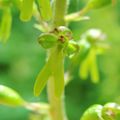Two-leaf
| Two-leaf | ||||||||||||
|---|---|---|---|---|---|---|---|---|---|---|---|---|

Illustration: Left: Large two-leaf ( Listera ovata ) |
||||||||||||
| Systematics | ||||||||||||
|
||||||||||||
| Scientific name | ||||||||||||
| Listera | ||||||||||||
| R.Br. |
Two sheet ( Listera ) the name is a plant genus in the family of orchids (Orchidaceae).
The genus was established in 1813 by the British botanist Robert Brown (1773-1858) and named after the English doctor and naturalist Dr. Martin Lister (1638-1712) named. According to more recent findings, all species are now in the genus Neottia Guett. posed.
description
The inconspicuous species of the genus Zwelatt ( Listera ) differ mainly in the size and proportions of their flowers and leaves. The plants are perennial growing rhizome - geophytes with straight, thin, horizontal creeping rhizomes. The stems usually have two opposite leaves .
The spurless flowers are bell-shaped and form a tongue-shaped, two-part lip (labellum) that is twice as long as the tepals .
The flowering time of the two European species extends from the beginning of May to the beginning of August, depending on the altitude.
Types (selection)
The more than 30 species of this genus are distributed over the temperate zones of the entire northern hemisphere . The occurrence extends from northern Alaska up to 4000 m altitude in the Central Asian mountains.
- In Europe, two species are native:
- Small two-leaf or heart two-leaf ( Listera cordata (L.) R. Br. , Syn .: Neottia cordata (L.) Rich. )
- Large two-leaf ( Listera ovata (L.) R. Br. , Syn .: Neottia ovata (L.) Bluff & Fingerh. )
Other types are (selection):
|
|
Taxonomy
According to more recent taxonomic knowledge, the genus Listera is assigned to the genus of the nest root ( Neottia ). One of the results of these investigations was the fact that Listera cordata is to be regarded as a sister to a branch with Listera ovata and Neottia nidus-avis . As a result, the genus Listera has not proven to be monophyletic and may no longer exist. Since Neottia is the older generic name, it is already listed in current literature for two-leaves. However, this change has not yet become widely accepted.
Picture gallery
Large two-leaf
( Listera ovata ),
flowerSmall two-leaf
( Listera cordata ), inflorescence
Sources and further information
literature
Standard literature on orchids:
- Working groups local orchids (ed.): The orchids of Germany. Working groups of domestic orchids, Uhlstädt-Kirchhasel 2005, ISBN 3-00-014853-1 .
- Helmut Baumann , Siegfried Künkele : The wild growing orchids of Europe. Franckh, Stuttgart 1982, ISBN 3-440-05068-8 .
- Hans Sundermann : European and Mediterranean orchids. 2nd Edition. Brücke, Hildesheim 1975, ISBN 3-87105-010-5 .
- FG Brieger u. a. (Ed.): The orchids. Your description, culture and breeding. Founded by Rudolf Schlechter. 4 volumes and registers. 3rd, completely revised edition. Parey and Blackwell, Berlin 1985-2003.
See also
Web links
- Orchids of Southern Styria Listera ovata Large two-leaf
- www.guenther-blaich.de: Listera cordata
- www.guenther-blaich.de: Listera ovata




